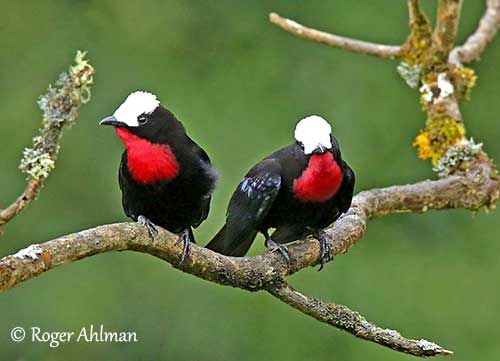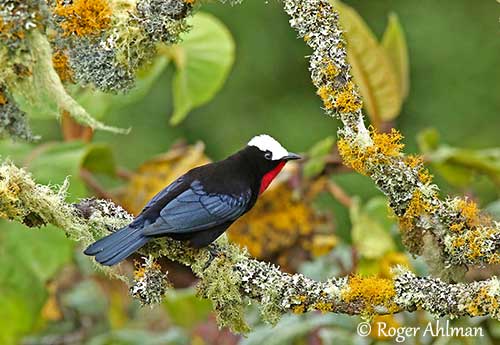
Fr: Tangara à coiffe blanche
Ang: White-capped Tanager
All: Weißkappentangare
Esp: Tangara Coroniblanca
Ita: Tanagra capobianco
Nd: Witkaptangare
Sd: vitkronad tangara
Photographer:
Roger Ahlman
Pbase Galleries Peru and Ecuador & My bird pictures on IBC
Text by Nicole Bouglouan
Sources:
HANDBOOK OF THE BIRDS OF THE WORLD Vol 16 by Josep del Hoyo- Andrew Elliot-David Christie – Lynx Edicions – ISBN: 9788496553781
BIRDS OF SOUTH AMERICA – Passerines - by Robert S. Ridgely and Guy Tudor – HELM Field Guides – ISBN: 9781408113424
A GUIDE TO THE BIRDS OF COLOMBIA by Steven L. Hilty and William L. Brown - Princeton University Press – ISBN 069108372X
TANAGERS: Natural History, Distribution and Identification (Helm Identification Guides) - By Morton L. Isler and Phyllis R. Isler - Christopher Helm Publishers Ltd; New edition (30 April 1999) - ISBN-10: 0713651164
Birds of Ecuador De Robin Restall, Juan Freile - Bloomsbury Publishing, 2019 – ISBN: 147297249X, 9781472972491 - 576 pages
Neotropical Birds – Cornell Lab of Ornithology
Wikipedia, the free encyclopaedia
Fundacion EcoMinda - White-capped Tanager (Sericossypha albocristata)
SORA - Observations on the nesting and diet of the White-capped Tanager in Eastern Ecuador
White-capped Tanager
Sericossypha albocristata
Passeriformes Order – Thraupidae Family
INTRODUCTION:
The White-capped Tanager is a large, spectacular and unmistakable tanager from the northern part of the Andes of South America. Although being widespread in its cloud forest habitat, it is often seen at low densities.
This noisy bird can be seen up to 3,000-3,200 metres of elevation in humid montane forest. It feeds both on vegetable matter and animal prey, including wasp’s larvae, and usually forages in canopy or top of bushes at forest borders.
The social structure of this species differs from other tanager species. The adults travel in small groups of about 20 individuals, but often with only one male. This species probably performs communal breeding.
The White-capped Tanager is threatened by deforestation and forest fragmentation within its high Andean range. However, the species occurs in several protected areas, but it is currently listed as Vulnerable.

DESCRIPTION OF THE BIRD:
Biometrics:
Length: 23-24 cm
Weight: 95-125 g
The White-capped Tanager is a large Thraupidae with very conspicuous white crown. The male has glossy black plumage overall, except the crimson chin, throat and breast. Wings and tail are mostly blue-black.
On the head, lores and forecrown to mid-crown are pure white, contrasting with the black plumage.
The fairly stout bill is blackish. The eyes are dark brown. Strong legs and feet are dark grey.
The female resembles male, but chin, throat and breast are duller and darker red, and less extensive than in male.
The juvenile has black plumage. It already has the white crown but it lacks the red area.
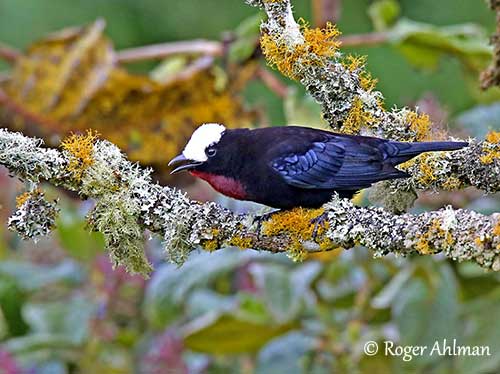
RANGE:
The White-capped Tanager is found in Venezuela, Colombia, Ecuador and Peru.
In Colombia, it occurs on the eastern slope of central Andes near the border between Caldas and Tolima, and on the western slope of central Andes in Cauca. It is also present in the upper Magdalena Valley in Huila, and S through Cauca and Nariño to Ecuador and C Peru. The species also occurs on the eastern slopes of the Andes in Táchira in Venezuela.
HABITAT:
The White-capped Tanager frequents humid forest and forest borders, and it is usually commoner in higher, mossy forest than along forest borders or tall second growth.
The species occurs at high elevations, from 1,600 to 3,200 metres in Colombia, or 1,750 to 3,000 metres in Ecuador, and 1,700 to 2,800 metres in Peru. It is usually most numerous between 1,900 and 2,700 metres of elevation.
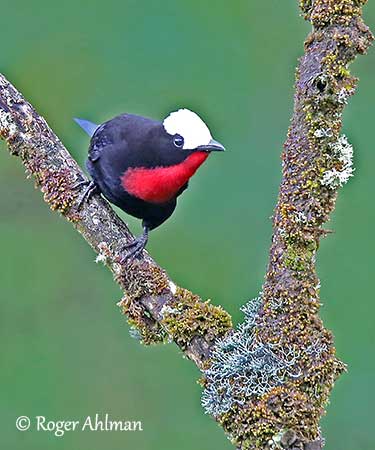
CALLS AND SONGS: SOUNDS BY XENO-CANTO
The White-capped Tanager is usually very noisy and often heard before to be seen. It constantly repeats a loud “peeeaap” sometimes followed by one or two sharp, piercing “keep”, “peer” or “kip” notes. It may utter up to 40 notes / minutes or more irregular, but it may also continue during several minutes, up to 8-9 minutes.
These far-carrying calls indicate the approach of a group, and they are also given in flight.
BEHAVIOUR IN THE WILD:
The White-capped Tanager probably feeds both on vegetable matter and animal prey. Contents of stomachs included fruit pulp, seeds, ants, wasps, bees, coleopteran and dipteran larvae.
This species usually forages in treetops, especially in tall trees, or occasionally at top of bushes or second growth. They often forage in groups of 4-8 individuals, but groups of 20 birds are not uncommon. They are probably family groups as they only contain one adult male. While foraging, they peer, posture and cock their tails, and also hop and leap through the trees.
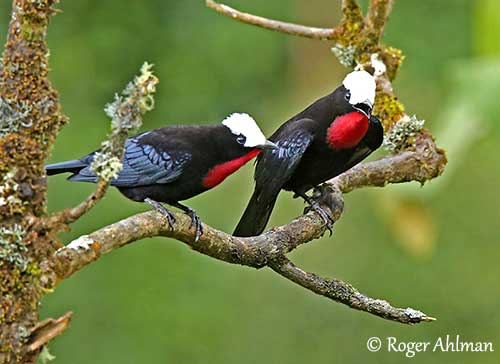
The breeding behaviour of the White-capped Tanager is poorly known, but cooperative breeding is suspected. The white head and the red throat and breast probably play a role in courtship displays, when they are enhanced by adapted postures.
The cup-shaped nest is built in tree fern, well hidden by fronds.
The White-capped Tanager is endemic to South America, but it may wander seasonally, probably depending on food availability.
This species often hops and leaps through the trees like jays, and they rapidly fly on. The flocks cover long distances through the forest canopy, then perching in the open before flying quite high.
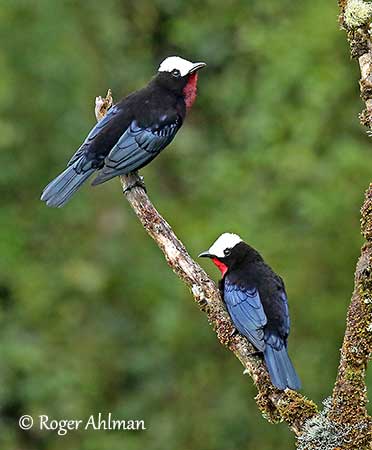
REPRODUCTION OF THIS SPECIES:
Only one nest was found in mid-January in eastern Ecuador. It was built in tree fern (Cyatheaceae) of about 12 metres tall, and was placed in the centre of the trunk in the crown, well hidden by the fronds.
The cup was loosely built with rootlets and pale-coloured fibres. Only one chick was found in the nest. It was well-feathered, and the dull white patch was already visible on the head. It was very vocal, especially when one adult was in the vicinity of the nest. Up to 4 adults (3 males and 1 female) brought food to the chick, but they visited the nest singly.
The nestling was finally observed out of the nest on January 22. It was perched on a frond adjacent to the nest and still fed by the adults.
No other information.
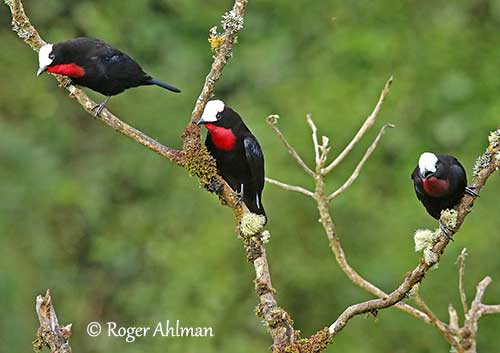
PROTECTION / THREATS / STATUS:
The White-capped Tanager is affected by habitat loss through deforestation. The species occurs in several large protected areas within its range.
The size of the population is unknown, but the species is described as “uncommon and patchily distributed”. It is suspected to decline.
The White-capped Tanager is currently listed as Vulnerable.
